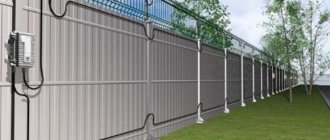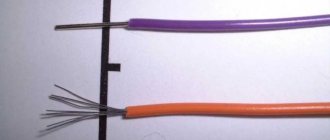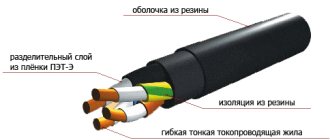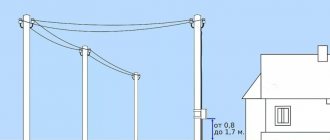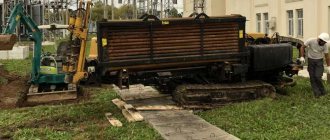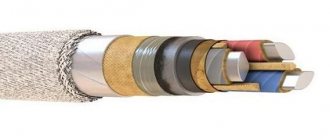Cabling - this is not just unwinding of conductor products along its future route - this is a rather complex technological process that requires the use of various mechanical devices and devices. There are several unwinding methods, each of which involves lifting the drum above the surface level by at least 0.2 m, and the cable should come off from above. This is an important condition, because the conductor (especially in armored braiding) can bend in an arc, which, resting against the base, will interfere with the rotation of the drum. In this article we will tell you how to unwind a cable from a drum/coil and look at the main methods.
Basic unwinding methods
Depending on the cross-section of the cable, its rigidity, and the presence of a protective sheath, its unwinding is carried out using movable, stationary or manual mechanisms. They must ensure lifting of the drum and its free rotation, eliminating the breaking load on the conductor.
Thus, the process can be carried out using:
- special trailer (cable conveyor);
- an ordinary vehicle (car, tractor);
- winches (electrically driven, manual);
- manually (over short distances).
These methods are the most commonly used, and each of them needs more detailed study.
Use of specialized equipment
Trailers for transporting and laying cables are effectively used to place the conductor in an open manner or by placing it in the ground (prepared trenches - routes). It is especially practical to use when working with products in a rigid and armored protective shell.
| Advantages | Flaws |
| Indispensable for long-distance installations | Inability to use inside buildings |
| Load capacity up to 3-4 tons | Expensive |
| Possibility of placing from 1 to 3 coils simultaneously |
The cable conveyor is used for transporting drums with cable and for unwinding the conductor during its laying.
The only disadvantage of special trailers is their considerable cost. Therefore, the main users of this technology are enterprises specializing in large volumes of work.
Vehicle use
A common practice is to unwind the cable using a machine or tractor. There are two possible options:
- The drum is installed on a metal structure that allows it to rotate freely in the body or on a carriage. The free end is securely fixed at the beginning of the line, and unwinding occurs as the vehicle moves to its destination
- The drum is installed and secured on a rotating device, and the free end of the cable is attached to the car, which produces tension.
| Advantages | Flaws |
| Simplicity and accessibility of the method | The need for additional structure to rotate the drum |
| Significant load capacity | Difficulties with loading and unloading |
| Applicability of different options |
Practical advice: constant control over the unwinding process is mandatory to avoid damage to the product.
Cable unwinding from the machine can be carried out over long distances subject to constant monitoring
Application of unwinding winch
This option is very convenient in terms of practicality, but it limits actions over long distances, which are limited by the length of the cable on the winch. The versatility of the method lies in the possibility of laying a conductor through pipes or cavity structural elements, as well as its applicability for both horizontal and vertical pulling. In addition, with vertical unwinding, movement can be made in any direction - from above or from below.
| Advantages | Flaws |
| Ease and simplicity of the process | Inability to use over long distances |
| Ability to work in different planes and angles of inclination | The need to use guide rollers |
| Availability of installation through holes, openings, pipes | |
| Applicability inside buildings |
Carrying out work manually
Manual unwinding is similar to the previous method of working with a winch, but is significantly limited by the distance, which when working with heavy products can be a little more than 20 m. Very often this method is combined with other methods. That is, the cable is pulled by hand through some structure or cavity, and further tension is carried out by a mechanism.
Unwinding the cable by hand can be done in different ways, but it is limited in length
Benefits of the tool
Cable installers know how much time it takes to unwind conductors by hand. Especially if the work is done in a confined space. Our cable unwinding will help solve all problems. The advantages of the product include:
• compact dimensions; • light weight. The unwinding can be carried and installed manually, without the use of special tools; • ease of transportation. If necessary, the device can be disassembled into separate units and assembled in a few minutes at the work site; • no need for technical and service maintenance. It is enough to periodically check the integrity of its components and the condition of the bearing.
Our company offers the best model of mechanical unwinder, which will serve properly for a long time. Pay attention to the cost of the product. Such products can be purchased by a private entrepreneur working with conductors of various types, as well as small and medium-sized businesses seeking to reduce their production costs.
Please note that the cable unwinder can be used both with simple conductors and with wires placed in corrugation. This versatility saves a lot of time and significantly increases the productivity of work performed. Look at the product card and give your assessment of our products.
Devices for unwinding cable and wire products
The devices on which the drum is placed for unwinding the cable from it can be very simple, made in the form of a metal structure of thrust posts and a crossbar located between them, on which the reel is placed. Complex devices can also be used, combining units and mechanisms that facilitate the process of pulling even from large and heavy reels.
Drum unwinder UNIROLLER 500 rol 90101
UNIROLLER 500 device is a compact cable unwinder from small drums weighing up to 140 kg.
Lightweight mobile device for unwinding coils weighing up to 140 kg with a small diameter. The model is equipped with four rollers, with the help of which it can move independently along with the cable reel placed on it. The weight of the product is 8 kg with dimensions: length 53 cm, width 55 cm, height 10 cm.
The device is perfect for indoor use, as well as in the back of a truck or the interior of a utility vehicle. The rotation of the coil is carried out using two durable rollers on which it is installed. The average market price of the product in online stores is 21,000 rubles.
Drum unwinder UNIROLLER 700 rol 90102
This design is used to work with cable reels with a diameter from 0.5 m to 1.8 m and a weight of up to 1.5 tons. It consists of two parts, which are small in size and can be easily delivered to the installation site by any transport. The device can be used even in very cramped conditions. Dimensions are 120.6x27.7x19.5 cm (length-width-height), total weight - 34 kg (each part - 17 kg).
The rotation of the drum occurs due to bearings built into the base of the product, and its lifting and braking is carried out using special levers. The estimated cost in the online store is 155,000 rubles.
The UNIROLLER 700 device is a cable unwinder from drums weighing up to 1.5 tons, with a diameter of up to 1.8 meters. The product can be used inside buildings, as well as outdoors, when installed on a flat, hard surface.
Model UNIROLLER 900 rol 90121
The device with a hydraulic lift is designed for winding and unwinding cable products from drums with a diameter of up to 2.2 m, weighing up to 6.0 tons. It consists of a pair of metal supports, each equipped with two wheels and a hydraulic lifting device. Between them there is a pipe that acts as an axis for hanging the coil. The height of each support is 112 cm, weight – 45 kg. Axle length 185 cm.
The hydraulic lifts are operated by a foot drive. The universal design can be used on any site that has a sufficiently flat, hard surface that can withstand the weight of the cable drum. Additionally, the device can be equipped with an axle 150 cm long, which will expand the range of serviceable drums. The cost of the device in the online store is about 299 thousand rubles.
The design of UNIROLLER 900 is suitable for working with large and heavy cable drums weighing up to 6.0 tons
Using a cable unwinding crane
When carrying out work on construction and installation sites where there are cranes or access by motor vehicles, in particular a truck crane, is possible, unwinding of cable and wire products is allowed using them. To do this, it is necessary to correctly sling the coil through the pipe, which will play the role of a giving axis.
The advantages of this method are:
- applicability for working with any weight of cable drum;
- the ability to climb to the desired floor;
- permissibility of work in both horizontal and vertical planes.
The main condition for using cranes for unwinding cable and wire products is reliable lashing, which prevents the drum from falling. However, unwinding a cable directly from a suspended drum is done extremely rarely and in the most exceptional cases. The main purpose of a crane (beam crane, hoist) is to place the reel on the racks.
Description
During the installation of electrical wiring, Internet lines, fire alarm systems and video surveillance, problems often arise with unwinding cable coils that get tangled, entangled and twisted. It doesn't make much difference how you unwind the bay, from the inside or the outside. In any case, it is uncomfortable and physically difficult. It is more profitable in all respects to purchase a special device, a cable unwinder, and once and for all solve the issue of laying long conductors. We present to your attention a simple and inexpensive model that has passed technical tests and is appreciated by practicing installers. You can buy it in our online store with delivery to any region of the Russian Federation. Take advantage of our offers and appreciate the economic benefits of using our accessories for cable products.
Features of cable unwinding at subzero temperatures
There are brands of conductors whose insulation is made specifically for northern climatic conditions. Such products are allowed for installation at temperatures down to -50 °C. However, the majority of products lose their insulation elasticity at negative ambient temperatures, which can lead to damage during installation. Therefore, it is not recommended to carry out such work in winter.
If the need for unwinding nevertheless arises, then any manipulations with the wire should be preceded by warming it up. It is carried out either indoors or in a heated tent where the bay is placed. The duration of warming up directly depends on the temperature achieved:
- +5-10°С – at least 3 days;
- +10-25°С – at least 1 day;
- +25-40°C – 18 hours is enough.
In addition, the cable can be heated using three-phase current. The electric current passed through the coil for heating should not exceed 75% of the permissible value for the conductor brand and core cross-section. It is also necessary to monitor the temperature of the outer cover of the insulation - it should not rise more than 20°C .
Current questions and answers to them
Question No. 1. Is it permissible, in the absence of a device for unwinding the cable, to lay the drum on its side and, removing the cable in rings, lay it along the route?
Such actions are a gross violation of technology.
Question No. 2. Is it allowed to use an open fire, such as a bonfire, when warming up a guide in a tent?
The use of open fire to warm the cable is strictly prohibited. If it ignites, it will be very difficult to extinguish it, and further use in electrical networks will be impossible.
Question No. 3. Is it possible to use two UNIROLLER 500 to unwind one large bobbin?
Practice shows that such cases do occur, but such a solution cannot be called correct. You could end up losing expensive devices and not getting the job done. The bosses will not be happy with this result.
Cable jacks for winding and unwinding
According to the operating principle, jacks used for unwinding or winding cables are divided into:
- hydraulic, operating due to fluid pressure inside the working cylinder;
- threaded, which feed by moving the screw along the thread through the nut;
- lever, working on the principle of a lever, using the difference in the length of the cradle and the main arm.
You can consider the effect of structures using specific examples:
- Model DG 20 (hydraulic jack). Purpose – work with cable drums D 2-3.5 m, weighing up to 20 tons. Device weight – 520 kg
- Model DV 26-5 (screw jack). Purpose – lifting for unwinding reels of cable D 0.8-2.6 m, weighing 5 tons. Device weight 180 kg
- Mechanical (lever) models are mainly used for lifting small weight drums and then placing them on racks.
Screw cable jack allows you to lift the drum above ground level for unwinding and laying cables
Making a jack with your own hands
A jack for hanging cable drums can be made independently, subject to certain conditions. To create such a design, you will need a channel, a thick-walled pipe D 50 mm, two M 22 threaded studs 40-50 cm long, 2 M 22 nuts, and a welding machine.
- 50 cm long pipe is welded to a section of channel 60 cm long, in the middle at an angle of 90 °
- A sleeve is welded into the upper part of the pipe so that the screw, passing tightly through its hole, is placed inside the pipe
- A piece of channel is welded to one end of the screw, forming a bed
- A nut with a collar welded to it is screwed onto the other end of the screw, up to the stock.
- The free end of the stud is placed in the sleeve and lowered into the pipe
- The second rack is made in the same way
- For greater stability, additional stops can be welded to the sides of the pipe.
- A pipe is placed on the stock between the two posts and threaded into the hole of the drum. By rotating the nuts using cranks, the studs move out of the pipes, lifting the crossbar with the coil.
Practical advice: It is not recommended to use homemade jacks for lifting large, heavy bobbins weighing more than a ton. For these purposes, industrial products are used that are designed for a certain load in design bureaus.

